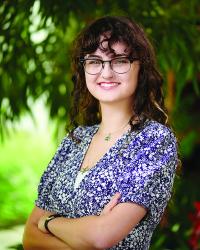Annie Jump Cannon’s Stellar Achievements
Spring
2024
Special Feature
Annie Jump Cannon’s Stellar Achievements
Rianna Ehrenreich, Intern, SPS Office, and SPS Member, University of Rochester
11-feature-Cannon-1.jpg

Rianna Ehrenreich.
For centuries astronomy was largely viewed as a man’s study. So when the director of the Harvard College Observatory, Edward Pickering, needed people to classify and catalog the spectra of stars in the 1870s, he delegated the repetitive and unwanted task to a group of women he oversaw—referred to as “computers.” It was here that Annie Jump Cannon, or as National Women’s History Museum fellow Kerri Alexander refers to her, the “census taker of the sky,”1 began her astronomy work.
Cannon graduated from Wellesley College in 1884 with a degree in physics. After taking time to travel and focus on photography, she joined Pickering’s group in 1896. Classifying stars via their spectra was a disorganized process at the time due to a multitude of convoluted classification systems.
Cannon had a fantastic memory. As George Greenstein, an emeritus professor of astronomy at Amherst College, wrote, she “knew each star’s spectrum as an individual,”2 giving her unique insight as to how stars should be grouped. This talent was put to use in a 1901 publication where Cannon expertly revised a preexisting classification system. She reorganized the stars into categories O, B, A, F, G, K, and M according to the strengths of some of their absorption lines. Astronomers still classify stars based on this system.
At the time the relationship between star color, spectra, and temperature was unclear, but it turns out that Cannon was classifying stars by temperature (O is hottest, M is coolest). Cannon's system was the direct result of her intense work ethic and astronomical brilliance; she classified about 350,000 stars during her lifetime.
Cannon was published in 11 volumes of the first large-scale stellar catalog, the Henry Draper Catalogue (1918–24), and in its follow-up, the Henry Draper Extension (1925). She discovered about 300 variable stars and five novae. In 1911 she was promoted to curator of astronomical photographs for the observatory. Despite this, Cannon did not become an official member of the Harvard faculty until 1938, where she taught astronomy.
She received multiple honorary degrees and was the first woman to receive the Henry Draper Medal of the National Academy of Sciences and be an officer in the American Astronomical Society. Cannon was additionally a proud suffragist and voted one of the 12 greatest living women in America by the National League of Women Voters in 1923.
It’s hard to believe that early in her career, Cannon was not allowed to use the telescope regularly, as some thought “it was dangerous for a woman to observe alone and inappropriate for one to spend the night with a man,” according to Greenstein.3 She overcame additional adversities as well; for example, by the time Cannon joined Pickering’s group, she was deaf.
Cannon’s contributions were likely limited as a product of her time. Female astronomers worked repetitive and often unrewarding jobs, quietly supplying data for male astronomers to analyze. Nevertheless, Cannon’s genius set the stage for our current understanding of stars and stellar evolution. She continues to inspire astronomers, perhaps especially gender-minority astronomers, proving that nothing can keep us from the stars.
References
- Kerri Lee Alexander, Annie Jump Cannon (Alexandria, VA: National Women’s History Museum, 2020), womenshistory.org/education-resources/biographies/annie-jump-cannon.
- George Greenstein, “SCIENCE: The Ladies of Observatory Hill: Annie Jump Cannon and Cecilia Payne-Gaposchkin.” The American Scholar 62, no. 3 (1993): 437–446, jstor.org/stable/41212156.
- Ibid.

